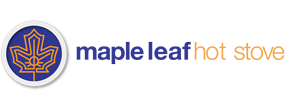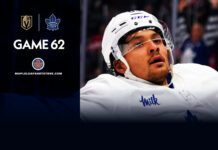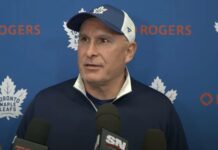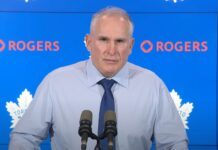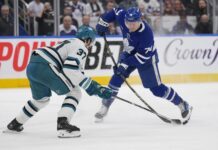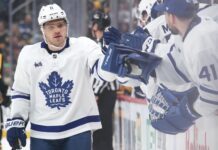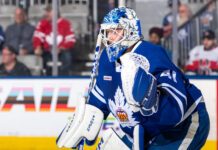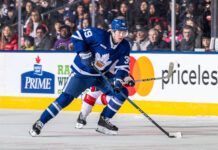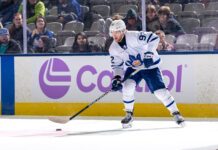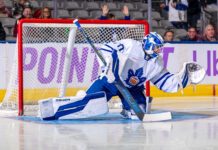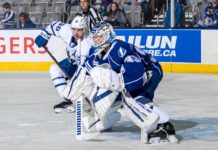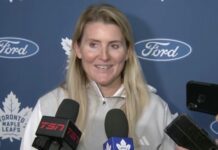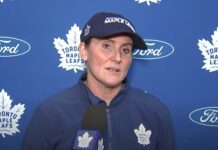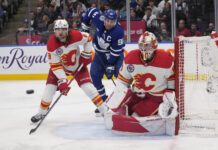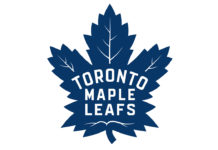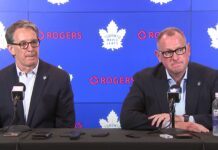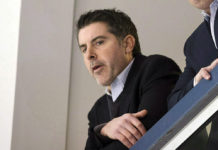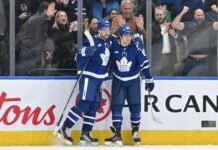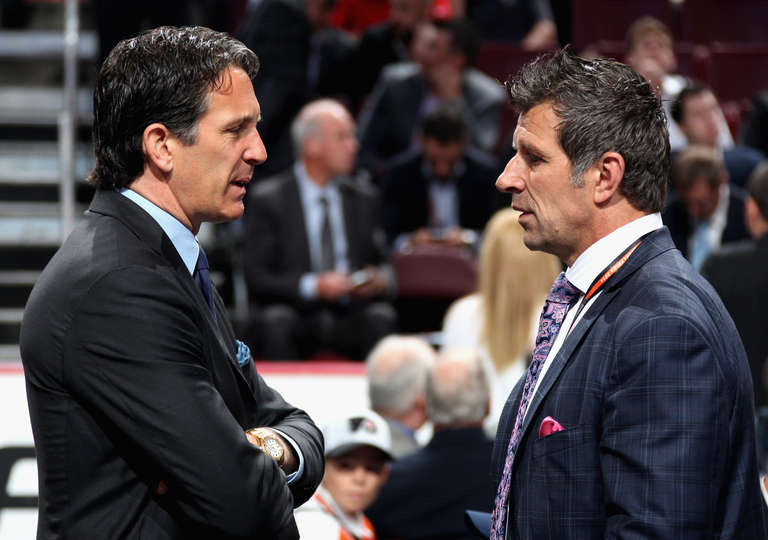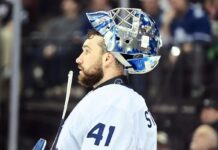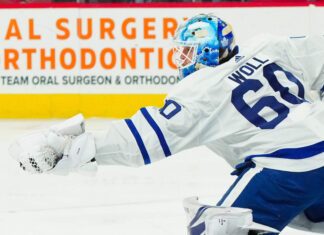When Brendan Shanahan was introduced as the new President of the Toronto Maple Leafs, it was met with skepticism and the focus centered on Tim Leiweke’s consistent reiteration of the word “culture.”
Conversely, Shanahan’s focus was not on buzzwords of culture change, or calls to arms, but a methodical approach to assessing and addressing the needs of a team that has very good parts but ultimately is a poorly built team. “I’m not here today for big speeches, big words, big proclamations; None of that matters. Wins do,” Shanahan said at the time. He is right, wins are what matter. But on second look at that press conference, it was maybe a bit more revealing than given credit for. “I do like a lot about this group. There are some good pieces a lot of teams would covet,” Shanahan told everyone. “You start to look at making improvements in small increments,” he said, alluding to their offseason plan quite accurately. The Leafs were simply “not deep enough,” Nonis added. In Elliotte Friedman’s last ’30 Thoughts’ of the season, he too noted that: [pull_quote_center]28. One of Toronto’s players said it was very clear after the season the organization wants to even-out everyone’s ice time, both up front and on defence. The feeling was a number of critical players — Phil Kessel, Dion Phaneuf, James van Riemsdyk — hit the wall.[/pull_quote_center] So far, the Leafs have stuck to the script. Earlier in the summer, I wrote about the Leafs bottom six and their lack of production, specifically when it came to the third line.
In a nutshell, it said:
- The Leafs third line had the worst points per game in the league compared to other third lines.
- The bottom six couldn’t help kill penalties.
- The bottom six couldn’t help protect a lead, in which the Leafs led the league in blown third period leads.
The bad penalty kill and inability to protect a lead don’t fall solely on the bottom six, but in the big picture they couldn’t help offensively, defensively, or on special teams. There is no nice way of saying that. That is how the Leafs ended up having three forwards in the top 12 of average time on ice (for forwards) in the league. The only other team in the league to have three forwards average 20+ minutes of ice time per game was Vancouver, and only 29 forwards in the entire league averaged 20+ minutes. To say nothing of JVR and Kessel playing in the Olympics, too. The second line had two 20+ goal scorers, and nearly a third (Raymond had 19). Both Lupul and Raymond are listed as left wingers on NHL.com, and they both finished in the top 30 at that position in ice time. They each would have finished in the top 30 as right wingers as well. This is getting magnified to really make it clear how bad the Leafs bottom six was, how much they relied on their top players because of it, and to highlight how the Leafs ran their top forwards right into the ground.
Their top six across the board, as illustrated, played a huge amount. Shanahan, true to his word about the team having good pieces — and to Nonis’ point about the lack of depth — has so far gone about reconstructing the rest of the roster around “the core,” which includes Kessel, JVR, Lupul, Kadri, Bozak, Phaneuf, Gardiner, and Rielly, with Bernier and Reimer in net.
Last season, Kulemin led the Leafs bottom six in scoring with 20 points. New additions Mike Santorelli and Daniel Winnik both topped that, Booth had one less point, Holland was on pace to beat 20 points, while Frattin, Komarov and even Bodie have flashed the ability to be at least reasonable contributors. In fact, if you combine Winnik’s 30 points, and Santorelli’s 28, they total more points than the Leafs most played entire bottom six based on games played (Kulemin, McClement, Clarkson, Bodie, Orr, Holland combined for 51).
That is why, despite a lack of big move to help boost the team and ignite the fan base, there is reason for optimism heading into next season. As per James Mirtle, the team got rid of six of their worst eight possession players. Every forward they have added has a history of strong underlying numbers, but beyond that they all bring different elements and styles to a bottom six that last year sorely lacked any sort of contribution to the team. Leo Komarov draws penalties and is excellent on the forecheck, David Booth works the walls and drives the net, Mike Santorelli is very fast and a dog-on-a-bone on loose pucks (similar to former Leaf Dominic Moore), Winnik is strong defensively and a big body, while Matt Frattin adds a big shot, physicality and speed. Peter Holland adds more size and skill. These are not the big and flashy names fans were hoping for to make a big difference, but it is hard to imagine they don’t significantly boost the worst bottom six in the league to at least the middle of the pack. And that is a big addition.
It has gone under the radar, but Shanahan has basically cleaned house—save for making any headline grabbing moves. There were 25 players that played at least 10 games for the Leafs last year and ended the season as a Leaf or Marlie, and 13 of them—over 50%—are either out of the organization entirely, or appear on their way to the Marlies for the start of next season. To date, six forwards and two new defensemen have been acquired. Three assistant coaches have been fired, two long-time management members, and Kyle Dubas and Peter Horachek have been brought in while Steve Spott has been promoted. All three have strong recent histories that suggest the Leafs just got a whole lot smarter and methodical in their approach, which will have a systemic trickle down effect to the on-ice product.
The reality is that all of Leafs Nation is on a completely different timeline than Brendan Shanahan. He just got here. He is trying to evaluate every corner of the organization. With everything that happened and what they lacked last year, it makes it extremely difficult to evaluate the core that many wanted blown up or at least altered, because they had no support. With the pieces put in place he can now do that. Provided the new additions fit in and contribute – and there’s more reason to believe they will than won’t — the eyes are all geared towards the core players now to step up and deliver. “This is the time for me to start learning about the organization from top to bottom,” Shanahan said in his introductory press conference. “It’s a time for me to listen, to learn and get to work. That’s all that’s really worked for me in my career. That’s what’s worked for me when I was done playing hockey and that’s what I intend to do here.”
With a handful of cheap, solid, productive acquisitions, and a revamped defense, he now has the opportunity to focus on the top of the roster properly and take the next step in his plan. The core players, Carlyle, and Nonis are all on the hot seat now, but at least they have an opportunity to succeed with what has been done. It is up to them to seize it now in conjunction with a solid supporting cast. “When I first started in Detroit, they weren’t the team they are,” Shanahan said about the once maligned and comically laughed at organization. “Sometimes success is just around the corner.” There is reason now to believe that might just be the case.
A few interesting notes I have been sitting on:
- With Carl Gunnarsson now off the team, Dion Phaneuf is sure to be paired with his best partner since Francois Beauchemin. Since the Leafs moved the veteran rearguard to Anaheim, Phaneuf has played with Keith Aulie, Mike Kostka, Korbinian Holzer, and Carl Gunnarsson. Any of Jake Gardiner, Morgan Rielly, or even Stephane Robidas, are big upgrades over any of those options. Gardiner and Rielly aren’t sure things yet, but it will be really interesting to see how Dion responds to playing with some legitimate talent in Toronto for once.
– - I have been over Clarkson’s shooting percentage and shots on goal count to illustrate why I think he will naturally bounce back (plus he probably won’t start next season with another ten game suspension…), but the Leafs have also brought in some wingers that play the game more suited to his style. Booth is very good along the boards and brings the puck hard to the net, Komarov works the walls well and engages in battles, while Winnik is a big strong body that goes to the net and can cycle. Kulemin was the only player Clarkson played with that could do this stuff, but with McClement as the center coupled with Kulemin’s complete lack of confidence, that just wasn’t going to get it done. Clarkson played a bit with Ashton at the end of the year, and looked very good working the wall. Their CF% was over 52 and although it was only a short period of time, to my eye it was the most comfortable Clarkson looked here- working the walls with another big body on the cycle and eating up offensive zone time.
– - Ashton, however, will be in really tough to crack the roster this year. Troy Bodie made a very good impression last season, can play both wings, is 6’5, and can fight a little, so save for a horrendous camp I think he is safe. Add in Petri Kontiola, who the Leafs brought over from Finland, and Ashton is facing an uphill battle. Perhaps the two-way deal should have been a tip-off.
– - Capgeek has too many forwards listed on the Leafs roster right now, so looking at the Leafs cap hit there at the moment, it should go without saying, is not correct. With three forwards most likely getting relegated, there is more than enough cap space to sign Gardiner and account for a seventh defenseman. I still wonder if Franson will start the season in Toronto.
– - As interesting, dynamic changing, and mindset swinging as the Kyle Dubas hiring and Dave Poulin plus Claude Loiselle firings were, only in Toronto does it get the coverage that it did. NHL GM hirings don’t get that much attention in some cities. Dubas will be a fresh addition to the staff, but to suggest the 28 year old who has never been a part of the NHL is ready to be a GM, or that the Leafs are about to fleece teams now that he has been hired, seems imprudent. There is stratospheres of difference between the OHL and NHL. Like any younger person joining a massive company, it takes time to learn the ropes and even just get your bearings. The SOO turned the corner towards the end of his tenure, but if you go look at his complete history (I’m not going to dissect it and criticize it) it wasn’t always smooth. He has a lot to learn and he knows that, but he is a great young management asset to groom. For me though, the signing says a lot more about Shanahan and where his head is at. I think we are at a point where we should be questioning if some of the things the Leafs were doing systemically and deployment wise last season should be obsolete. Shanahan is going to cut it off at the knees; he basically already has. He has two potential NHL head coaches standing on the bench as assistants right now, and he already blew a hole into upper immediate management. It is adapt or die time in Toronto right now. The stories have been about Dubas, Leiweke, culture change, and whatever else, but the real story is Shanahan putting succession plan pieces all into place and gearing up the organization for his tenure.
